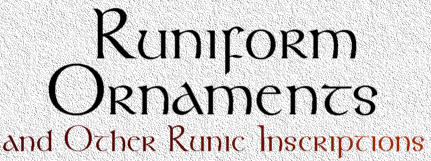

This page presents many runic inscriptions and carvings, no runic stones though. But only runiform ornaments made on artifacts and such, no stones.
I will present these runiform ornaments in order of age, starting with the oldest known today:
This page consist runiform ornament from the year 175 AD to the year 1900 AD!
Some of the inscriptions will have the runic inscription itself, along with the translitteration and the translation of it, and sometimes a picture too. The translitteration is when every rune is written down as a letter literally, which gives us a sence of the language and the pronunciation. Whenever a translitteration goes with the inscription, my translation will be very literal, in other cases more free, to make it sound more understandable, but still with a Scandinavian grammar. It is different from time to time. When I have any own comments, they are coloured in green...
I would prefer if you read the page "Runes" first, it consists small wav-files with pronunciation of runes and Scandinavian letters together with all other information you want/need to know.

raunijaR
The tester.
Spear-edge from Stabu, southern Norway.
Around the year 175.
owlþuþewaR
niwajemariR
Ull's servant,
the not very little famous.
Sword-ferrule from Torsbjerg, Sønderjylland (JUTLAND) in Denmark.
Around the year 200.
aisgRh
He who seeks hail.
Shield from Torsbjerg, Sønderjylland (JUTLAND) in Denmark.
Around the year 200.
warafnisa
?
The Næsbjerg-buckle from Denmark.
Around the year 200.
bidawarijaR
talgidai
Bidwar carved.
The Nøvling-buckle from Denmark.
Around the year 200.
ekunwod
I, the oh-furious
The Gardlösa-buckle from Scania, southern Sweden.
Around the year 200.
gaois
He who cries (SCREAMS).
Spear-edge from Mos, Gothland, south-east Sweden.
Around the year 200.
|
aadagasu laasauwija ?
This is very easy to read, you shall start with the bottom line - which is upside down - read from the right on the piture to the left, then the upper line which shall be read from the left to the right.
|
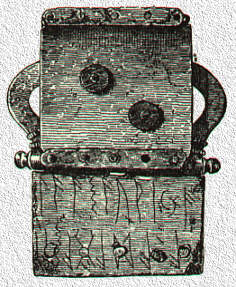
|
ranja
The piercer.
Spear-edge from Dahmdorf, Germany.
Around the year 250.
mariha iala
makija
Alli owns the famous sword.
Ferrule from Vimose, Denmark.
Around the year 250.

|
|
tilarids
Many spear-edges with runecarvings have been found. This one is in silver and shall be read from the right to the left.
Spear-edge from Kowel, Ucraina. |
|
harja
This is a camb made of bone, and the five runes seem to represent a name, probably a male, perhaps the owner himself?
Camb from Vimose, Denmark. |
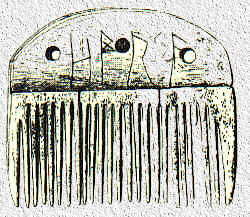
|
|
gutaniowi hailag
The first part (gutani...) points to the gothics, maybe in this sentence meaning "people". The last word is obviously sacred/holy. The middle word is then wih which could mean "wedding". The o-rune(OTHALA) stands for property / possesions.
Necklace-ring from Pietroassa, Romania. |
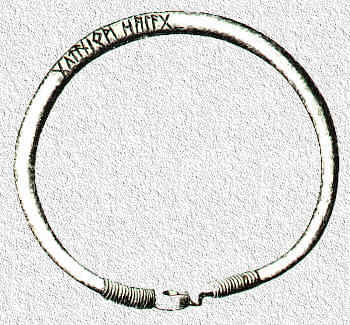
|
lina laukaR f
Flax, onions, wealth. (FLAX IS LIN IN SWEDISH TODAY AND ONIONS ARE CALLED LÖKAR...)
Knife of bone, Fløksand, Norway.
Around the year 350.
lua
Beer / ale / stout / mead.
The Swedish word for beer today is öl.
Read it from the right to the left = aul (BEER IS CALLED ÖL IN SWEDISH TODAY)
Spear-edge from Nydam, Denmark.
Around the year 400.
leþro
Female name.
Tiara from Strårup, sønderjylland(JUTLAND), Denmark.
Around the year 400.
|
ekhlewagasriR holtijaR horna tawido
I Hleguest,
This horn was found in the village Gallehus in Sønderjylland, Denmark in the year 1639, and in 1734, another one was found too. They were both in heavy gold and weighed more than |
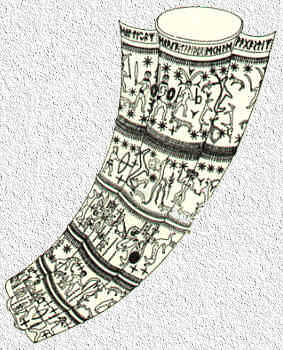
|

mkmrlawrta
I the Eril wrote.
This runiform ornament is probably copied from another runiform by somebody who couldn't carve or read runes himself, because the e-runes![]() are m-runes
are m-runes![]() instead. These two runes almost look the same, but only a person without knowledge would mix them up like this.
instead. These two runes almost look the same, but only a person without knowledge would mix them up like this.
It should say (COMPARE WITH THE NEXT RUNIFORM ORNAMENT TOO):
ekerlawrta
An Eril seems to be the title of a rune carver!
Buckle from Etelhem, Gothland, south-east Sweden.
Around the year 450.
ekerilaR
I the Eril.
Buckle from Bratsberg, Sør Trøndelag, Norway.
Around the year 500.
ek erilaRasugisalas
muhahaite
gagaga
ginuga
he... lija...
hagala
wijubi
I Asgisl's Eril,
is called Muha, (CALLED/NAMED IS HETA IN SWEDISH TODAY - TRANSLITTERATION IS HAITE)
ga-ga-ga
Original ga
.....
hail
I marry.
Spear from Kragehul, Denmark.
Around the year 500.
ekerilaR
sawilagarRhateka
aaaa
aaaa
RRR
nnn...
bmutt
:alu:
I the Eril,
is called SawilagaR,
Then there are eight AnruR-runes![]() , which stands for God (AS).
, which stands for God (AS).
Then comes three AlgiR-runes![]() which means Elk.
which means Elk.
Then three NaudiR-runes![]() which stands for need.
which stands for need.
Next the Berkana-rune![]() which stands for birch, then the MannaR-rune
which stands for birch, then the MannaR-rune![]() which means man and then an UruR-rune
which means man and then an UruR-rune![]() which stands for dizzyness.
which stands for dizzyness.
At last three TiwaR-runes![]() which are the rune of Tyr - the original God and the god of war. Tyr means God.
which are the rune of Tyr - the original God and the god of war. Tyr means God.
The last line says: May the power of the beer/ale/stout/mead protect!
Amulet from Lindholmen, Scania, southern Sweden.
Around the year 500.
My name is Hariuha,
I know the dangers,
I bring happiness.
Bracteat from Zealand, Denmark.
Around the year 500.
Luck for Alawin!
Luck for Alawin!
Luck for Alawin!
Good year, Alawin!
Bracteat from Skodborg, Denmark.
Around the year 500.
Hjäld for Kynmund
made the runes
on the foreign seed.
Bracteat from Tjurö(BULL-ISLAND), Blekinge, southern Sweden.
Around the year 500.
laþulaukaR
gakaRalu
Invitement onions
Spiked beer/ale/stout/mead (TRANSLITTERATED: Alu - IN SWEDISH TODAY: ÖL).
Bracteat from Scania, southern Sweden.
Around the year 500.
aluko
A female name, fun that is consists the word for beer/ale/stout/mead (TRANSLITTERATED: Alu - IN SWEDISH TODAY: ÖL).
From Førde, Norway.
Around the year 550.
I Arisboda blesses.
Godahild wishes joy.
Brackles from Bezenye, Hungary.
Around the year 550.
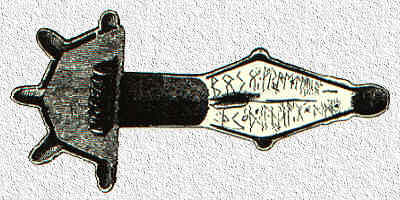
|
|
boso:wraetruna þk:daþïna:golda
Boso wrote rune This brackle was found in a grave belonging to a woman in Freilaubersheim, Germany.
Brackle from Freilaubersheim, Germany. |

The horn may wet
this slab of stone.
Scythe may cut,
haymaking lay.
Whetstone from Straum, Norway.
Around the year 600.
Awa and Leubwini,
Odin
Thor
Lodur.
Brackle from Nordendorf, Germany.
Around the year 600.
Ulfur and Odin and Hodir
helped rice against
Awerki and Tverkun Egbor.
Carving on skullbone, Denmark.
Around the year 750.
The bracklet is a
protection to traildom.
Bracklet from Strand, Sør-Trondelag, Norway.
Around the year 800.
The smoking
never obtained power
over you, Åsa!
auaaubi
fu:niluiai...
Stick from Hemdrup, Denmark.
Around the year 800.
litiluism
I belong to the little unit.
Oar from the Oseberg-ship, Norway.
Around the year 800.

An oxen
- for the guilt -
and coins two
when staff(STAVE) for the first time lays;
Oxen two
and coins four
for the other part;
but for the third part
oxen four
and coins eight for the staff(STAVE);
and all property remaining
if he does his full share.
What the people
owns requires by law,
it was consilidated long ago
and sacred.
But they did this to themselves,
Anund in Tåsta
and Ofeg in Hjorsta.
But Vibjörn carved.
Ring from Forsa, Hälsingland, Sweden.
Probably around the last part of the 800's.
These runes
were carved by the man
who knows most about runes
West of the sea.
On a wall in a barrow, Maeshowe 18, Orkney.
Mælbridge, son of Athakan smith,
raised this cross for his soul.
But Göt made this cross,
and all on Man.
I read (SOMEWHERE) that there are over 300 crosses with runes on the Isle of Man.
Cross from Isle of Man
Around the year 950.
|
This lion is not from Scandinavia, but from Piraeus, Greece, from where it was brought as a war-trofee to Venedig, Italy, where it stands today. It is made of marble and on its right side, somebody have carved a long runiform ornament somewhere in the 11:th century. It is believed that it was a drunk Swede that probably liked the lion-statuette and wanted to show he had been there. Unfortunately, the carving is so destroyed that it can't be read sufficient enough to translate. All I can tell you is that it is Swedish. |
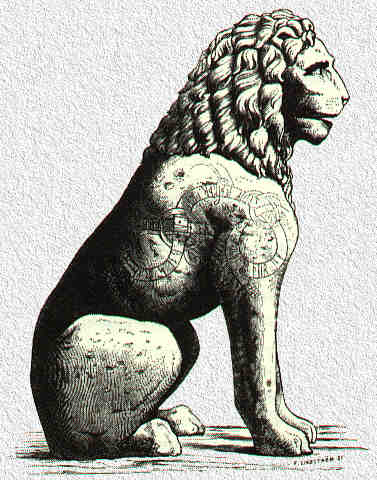
|
|
f u þ (FUTH)
Pussy
This word is the Old Norse word for the female genitals, and I am certain that the carvers were very aware of this!
Soapstone from Denmark. |
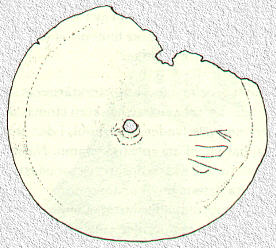
|
skuara(R) : iki
mar : afa
mon : mn krat
aallatti :
Sigvor's Ingemar
shall have my crying.
aallatti!
Part of a hand loom from Lund, Scania, southern Sweden.
Around the year 1000.
|
Brave recieved by a man from Samland these bowls... And Värmund carved these runes. The bird teared in the robber death-pale, it could be seen on the carcass-cuckoo how he expanded.
This is carved a box made of cupper and which contained a little shutable balance.
A little box from Sigtuna, Uppland, Sweden. |
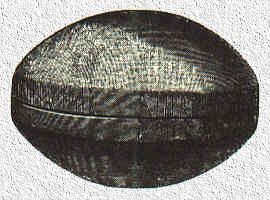
|
Götved gave this
brackle to Gudfred.
Brackle in bronze from Scania, southern Sweden.
Around the year 1000.
RRRRRRRRRRRR
RRRRRRRRRRRR
Radi took fauka
of his goods,
but I, Åsa,
have with this rewarded...
Brackle from Skabersjö, Scania, southern Sweden.
Brackle made in teh 700's, carving made around the year 1025.

Christ is victorious,
Christ is ruling,
Christ is offering.
Christ free me, Åsa,
from all evil.
Christ's cross be over me, Åsa,
here and everywhere.
+Christ's blood bless me+
Lead-plate from Odense, Denmark.
1100's.
I galdir (GALDIR=KIND OF OLD NORDIC SINGING AGAINST EVIL POWERS, LIKE TROLLS AND SUCH)
against the spirit of the dead,
against the spectre,
either he comes riding
or running,
shows himself sitting
or falling,
comes rushing
or flying.
In all guises
shall he loose
his life-strenght and die.
I just need to say that this one is SO COOL!!!
Inscription on a bronze-plate, found in Högstena grave-yard, Västergötland, Sweden.
Around the year 1100.
Against blood poisoning.
Gyril woundmaker,
go away,
found you are now.
Thor will get you,
you Drott of Tursir, (DROTT=KING - TURS=GIANT)
Gyril woundmaker.
The Canterbury-formula, United Kingdom.
Around the year 1100.
You Turs of wound-fever,
Drott of Tursir, (DROTT=KING - TURS=GIANT)
you flee now,
found are you!
If you have three
distress, wolf!
Then you have nine
now, you wolf!
It goes that way.
it goes to healing.
Enjoy the healing!
An amulet from Sigtuna, Uppland, Sweden.
Around the year 1100.
Then you hear
The dead has no stone
raised with runes.
Andi carved.
God help his soul.
A whet from Sigtuna, Sweden.
Around the year 1100.
You may think about me,
I think about you.
You may love me,
I love you.
Aww - how cute!!!
A knife used for weaving from Lödöse, Sweden.
1100's.
Bonde(FARMER) carved these speaking runes.
The eagle's oars are feathers.
Rib from Lund, Scania, southern Sweden.
Around the year 1100.
You may read the runes
which På carved.
Shroud needle from Lund, Scania, southern Sweden.
Around the year 1100.
Runes I carved
in real wood,
so reads the mighty son-in-law:
Asir in the oldest of times,
pell and mell,
Tell about your arse
as well as your belly.
This is obviously a joker that has carved to make fun with somebody, and for us to delight today.
A fiery cross with runes, Schleswig, Sønderjylland (JUTLAND).
Around the year 1100.
|
suæn kærþe
Sven made. (THE BAPTISMAL).
This baptismal also have clandestine runes on it.
Norum's baptismal from Bohuslän, Sweden. |

|
|
asmutr karþi dyr Asmund made (the) door.
Door knob from Värsås church, Västergötland, Sweden. |
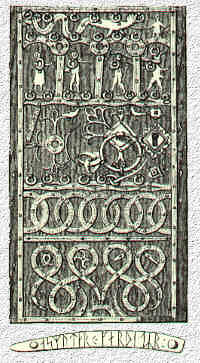
|
This is Saint Gabriel,
who said to Saint Mary,
that she was to give birth to a child.
This is Elisabeth and Mary,
who greet one another.
Here rests Mary, just as she had given birth to
the child, heaven's and earth's creator,
who relieved us.
These are the three Kings,
who first made sacrifices
to Our Lord.
Here he recieved, Our Lord,
the Kings's offerings.
Here they rode away,
the three Kings,
after having sacrificed
to Our Lord.
They gave this.
The Jews took Our Lord
and whipped him by the tree
and guarded him.
Then they led him
bounded away from there.
And here the Jews nailed
Jesus onto the cross.
Observe this.
Master Sigraf made the baptismal.
The text describes the reliefs of the baptismal.
Jesus is called God in these days.
Åkirkeby baptismal from the island Bornholm, Denmark.
The end of the 1100's.
The Norns made
both good and bad.
Great trouble
they decided
for me.
Does this runiform need a comment???
Isn't it just too sad - and too cool. They really did believe in the Norns!
Inscription from Borgund's church, Norway.
Around the year 1200.
Sigurd Jarlsson
carved these runes
the Saturday after Botulv's mass
when he had fled here
and didn't want to reconciliate
to Sverre,
his father's and his brother's slayer.
Inscription from Vinje's church, Telemark, Norway.
Around the year 1200.
Jon silk-pussy owns me,
and Guttorm pussy-licker carved me,
but Jon pussy-ball reads me.
No comment!
Stick from Bergen, Norway.
Around the year 1200.
Love turned
early for me
towards the woman,
the beautiful,
the poison.
Love conqueres all,
let's give in for love.
The two last lines are carved in Latin.
Bergen, Norway.
Around the year 1200.
Hail you
and may you become
friendly in mind.
May Thor recieve you.
May Odin own you.
Bergen, Norway.
Around the year 1200.
tihlsten
Brickstone
Inscription on a brick-stone from Nørre Løgum, Denmark.
Around the year 1200.
Katerina gives melody
for a believing people.
Here the sound is heard,
here an upset soul is being calmed.
The Bollebygd's bell from Västergötland, Sweden.
Around the year 1200.
|
When I was made it was the year thousand two hundred twenty winters and eight more from God's birth.
Ave Maria gracia plena.
The Saleby bell from Västergötland, Sweden. |
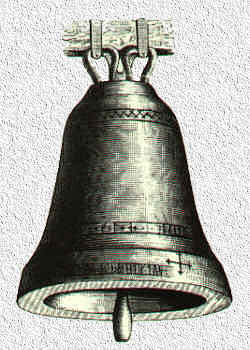
|
I carve healing-runes,
I carve stone-runes,
one against Elves,
two against Trolls,
three against Tursir ... (GIANTS)
Against the harmful
Skag-Valkyrie
so that she never
shall have
her way,
The damage-loving kona, (WOMAN)
with your life...
I send them on you
I seyd (BLACK MAGIC) them on you
the disguised wolf
with worry and desire.
May unbearable pain and
the mind of a mad man
fall upon you.
You shall never be able to sit calm,
you shall never be able to sleep in peace...
Love me like you love yourself.
Inscription on a stick, Bergen, Norway.
1300's.
In the mountains of Celion in the Kingdom of the Efesir
seven sacred sleepers are resting in peace,
Malcus, Maximianus, Marcianus,
Dionysius, Serapion,
Canstantinus, Johannis,
So may here rest
our Lord's Jesus's servant Bengta,
if she passes away in her illness.
In the name of the Father, the Son and
the Holy Spirit,
Amen.
Amulet in lead from Alvastra, Sweden.
Around the year 1300.
I beg the Earth to take care
and the high sky
Sun and holy Mary
and God himself, the Drott (KING)
to lend me
a hand of healing
and a tongue of healing
so I can heal wounds that would kill
when I need to heal.
Out of back
and out of chest,
out of body
and out of limb,
out from eyes
and out from ears,
out from all that,
where evil can come in.
Black is the name of a stone
he stands in the ocean.
Upon him lays nine in need.
They can't sleep
or wake up warm,
until you are healed
because of this,
I have made words of runes
to tell.
Amen.
And may it happen.
This is a very good example of the faith the people had in the runes, that they actually possesed magic powers. It is by the way also a mix between Christianity and the Æsir cult, even in the 1300's, people hadn't really let go of it, but turned to the old Gods in times of trouble.
Stave from Ribe, Denmark.
Around the year 1300.
| Cross in wood from around the year 1300, which was found in a grave on Greenland. The carving simply says the female name: maria which is the Nordic equivalent to Mary. |
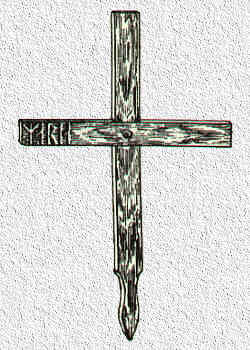
|
Haki Björnsson owns me,
Sven Osmundsson smithed me,
Osolv carved me
and locked the Wednesday
right after the mass of Olof
in the sixth year
of our honourable
Lord's rule,
Magnus, Norway's King.
Smithed door-handle from Rauland, Norway.
If the text above is correct, then the sixth year of King Magnus ruling and the day right after the mass of Olof - was July 31, 1325.
eko sum lapis
I am a stone
Inscription on a brick-stone from Löse, Blekinge, southern Sweden.
Brother Toki Efsa made me.
Brother Ingemar wrote on the bell.
Church bell from Boeslunde, Denmark.
By this cross-sign
shall all evil
fly far away.
Hardeberga church bell from Scania, southern Sweden.
Master Jakob Red
of Svendborg made
me. Jesus Christ.
Hesselager censer from Fyn, Denmark.
Johan i Gräne gave
this crown first to God
and Our Lady and the Holy Church,
to benefit his soul, and then...
Chandelier from Väte church, Gothland, Sweden.
|
olafr suthr giarþi us
Olof Söder made us. Gateposts from Vamlingsbro, Gothland, south-east Sweden. |
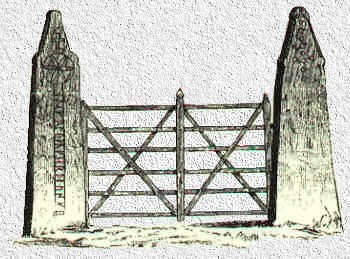
|
God is good,
it is true!
Scrawl in the belfry chamber in Bunge's church, Gothland, south-east Sweden.
Lavrans, son of Master Botvid
built this church.
They were from Eskelhem.
Inscription from Hellvi, Gothland, south-east Sweden.
Arund the year 1300

Send a prayer for Jakob's soul
in Nickarve.
He died five days
before Saint Lars' day.
Then the rune f was the letter of the Sunday
and the rune m the primestave
in the fifteenth row.
Wallinscription in Vänge's church, Gothland, south-east Sweden.
Around the year 1553
Anders has made
this bowl Anno 1596.
Bowl from Åsen's village, Sweden.
Year 1596
Each and everyone looks first
upon what he himself has done
before he criticizes
what I have done.
Chair from Lillhärdal, Härjedalen, Sweden.
Around the year 1600
ierk ulsun an afer
gort lofted 1635
ierk årdesu afer gort lof...
Erik Olsson he has
made (the) loft 1635
Erik Hårdsson has made (the) loft.
Loft from Orsa, Sweden.
The year 1635.
Mats Hindersson has
made this bowl
Hylkie Village
date September 9
Chopped in Persgrav from the stump
Anno year 1704.
Oh God please,
let it be filled
and never empty
with good, nice and sweet cream.
Then all would be good.
Milk-bowl from Hylkie, Sweden.
The year 1704.
|
||||||||||||||||||||||||||||||
|
Lead me, Jesus, here in life
|
||||||||||||||||||||||||||||||
|
||||||||||||||||||||||||||||||
|
To my right(ful) wandering goal
|
||||||||||||||||||||||||||||||
|
||||||||||||||||||||||||||||||
|
When I tired steps have taken
|
||||||||||||||||||||||||||||||
|
||||||||||||||||||||||||||||||
|
And no more wander bear
|
||||||||||||||||||||||||||||||
|
||||||||||||||||||||||||||||||
|
Be(come) oh Jesus then my peace
|
||||||||||||||||||||||||||||||
|
||||||||||||||||||||||||||||||
|
When me all ...
|
This was found in the wall of a little shed, and the inscription probably origins from the year 1729.
The Village of Åsen in Älvdalen, 1729, Sweden.
AAD gät 1900
Anna Andersdaughter tended cattle the year 1900.
Only the letters g and t are written with runes.
The last authentic rune carving by common people in Scandinavia ever...
:-(
A carving in a shed from the forest, Grylveån, Älvdalen, Sweden.